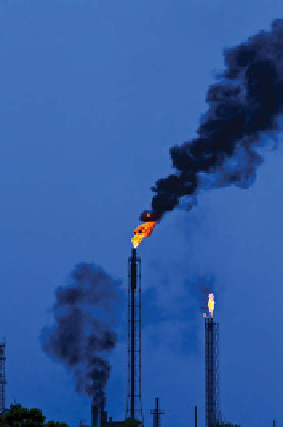Geoscience Reference
In-Depth Information
(a)
(b)
(c)
Figure 5.8.
Soot emissions from (a) natural gas flaring, Sisak, Croatia, June 29, 2009,
C
Srecko Petrovic/
Dreamstime.com; (b) a diesel locomotive,
C
Kenneth Sponsler/Dreamstime.com; and (c) a diesel ship,
Efired/Dreamstime.com.
C
vehicles. With aftertreatment, the ratio is reduced signif-
icantly, but diesel vehicles still emit 2 to 20 times more
particle mass than do gasoline vehicles. In the United
States, 99 percent of heavy-duty trucks and buses but
only 0.1 percent of light-duty vehicles use diesel fuel.
In Europe, 99 percent of heavy-duty trucks and buses
and over half of light-duty vehicles use diesel. In many
European countries, the largest sources of soot is diesel
engines.
Most soot from fossil fuels originates from coal,
diesel fuel, and jet fuel combustion. The smallest emit-
ted particles in diesel exhaust (
groups), which may be harmful. Gasoline vehicles emit
primarily semivolatile compounds with at least one peak
of 20- to 30-nm diameter and a larger peak smaller than
10 nm.
The
C
24
)semivolatile
organic components of both small and large diesel
exhaust particles readily evaporate upon dilution of the
exhaust, leaving the higher-molecular-weight organics
and BC in the particles. The resulting shrinkage of these
particles increases their rate of diffusion through the
air, and thus their rate of collision and coalescence with
each other to larger size (Jacobson et al., 2005).
lower-molecular-weight
(
<
15 nm in diameter)
are generally
semivolatile
(evaporating readily), con-
taining primarily unburned fuel (C
15
-C
23
organics),
unburned lubricating oil (C
15
-C
36
organics), and sul-
fate, and form during dilution and cooling of exhaust
(e.g., Kittelson, 1998; Sakurai et al., 2003). These par-
ticles generally do not contain BC because the diameter
of a single
BC spherule
is 5 to 50 nm with a mean
of 25 to 35 nm, and particles with BC contain tens
to hundreds of spherules aggregated together. As such,
BC aggregates
generally occur only in particles 15
to 200 nm in diameter. BC aggregates are coated by
polycyclic aromatic hydrocarbons (PAHs), unburned
fuel oil, and unburned lubricating oil (e.g., Steiner
et al., 1992; Sakurai et al., 2003). The PAHs include
nitro-PAHs (PAHs with nitrogen-containing functional
<
5.2.1.6. Industrial Sources
Many industrial processes involve the burning of fossil
fuels together with metals. As such, industrial com-
bustion emits soot, sulfate, fly ash, and metals. Fly
ash from industrial processes often contains Fe
2
O
3
(s),
Fe
3
O
4
(s), Al
2
O
3
(s), SiO
2
(s), and various carbonaceous
compounds that have been oxidized to different degrees
(Greenberg et al., 1978). Fly ash is emitted primarily
in the coarse mode (particles greater than 2.5
min
diameter). Metals are emitted during high-temperature
industrial processes, such as waste incineration, smelt-
ing, cement kilning, and power plant combustion. In
such cases, heavy metals vaporize at high temperature,
and then recondense onto soot and fly ash particles that




Search WWH ::

Custom Search